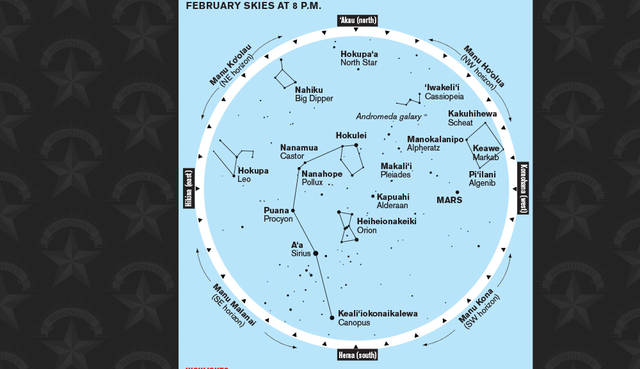Skywatch: Night sky provides stellar laboratories

COURTESY ‘IMILOA ASTRONOMY CENTER OF HAWAI‘I
Kekaomakali‘i arcs overhead, rising on the Hikina horizon (east) and moving toward the Komohana horizon (west). Within the bailer-shaped celestial image it carries Hokulei, or Capella; Nanamua and Nanahope, or Castor and Pollux; Puana, or Procyon; ‘A‘a, or Sirius; and Keali‘iokonaikalewa, or Canopus, chief of the southern skies. Seeing the first of the four star families is a reminder that a new year has begun. From about 2:30 a.m. until sunrise, Hanaiakamalama, the Southern Cross, can be seen arcing slowly across the southern horizon.
David Malo, Hawaii’s first royal historian and one of the first group of 25 young male Hawaiian students to attend Lahainaluna Seminary in 1831, provided the first primary source for the keeping of the Hawaiian calendar. A Kona resident, Malo grew up in an era when traditional Hawaiian religion and customs were still practiced. According to Malo there were two seasons: kau, or summer and hooilo, or winter.
The two seasons were divided into six-month cycles. The names of the 12 months and the particular 30-day lunar period that it pertained to differed from island to island. The months referenced here are for Hawaii island.
The summer season began in May and ran through October. The months were Ikiiki (May), Ka‘aona (June), Hinaia‘ele‘ele (July), Mahoemua (August), Mahoehope (September) and ‘Ikuwa (October).
The winter season began in November and ran through April. The months were Welehu (November), Makali‘i (December), Ka‘elo (January), Kaulua (February), Nana (March) and Welo (April).
The monthly Hawaiian lunar calendar had 30 nights called po. Because this was a visual calendar, on certain months the last po night may have been deliberately left off. Twelve months of 29 to 30 po would have meant that over one year the calendar would have drifted 10.75 days as compared with the Gregorian calendar. To calibrate this difference in drift so that the names matched the observable night sky, every three years the kahuna kilo hoku — one who is skilled at astronomical observations — would need to adjust the calendar by inserting an additional month. We have no documentation of this process, but we know this was a practice in the South Pacific.
Don't miss out on what's happening!
Stay in touch with breaking news, as it happens, conveniently in your email inbox. It's FREE!
Evening observations
Among the star line of Kekaomakali‘i, a multitude of famous astronomical objects are easily spotted. Beneath the famous three stars of Kaheiheionakeiki, or Orion, we can see a few stars that are often considered to be Orion’s sword. Behind these stars we can sight faint fuzziness that is the glow from the Orion Nebula (M42), a larger stellar nursery and the closest region of massive star formation to Earth.
Almost 37 degrees to the northwest of Kaheiheionakeiki is the open star cluster of Makali‘i, also known as the Pleiades or the Seven Sisters. This 75 million- to 150 million-year-old star cluster contains more than a thousand stars of all different types. Open clusters like Makali‘i act as stellar laboratories and allow astronomers to study how different varieties of stars live and die. To see what is left over after a massive star dies, we don’t need to look far.
In the horns of the Greek constellation Taurus, 22 degrees north of Orion’s belt, we can observe the Crab Nebula through a telescope. This stunning nebula is the result of a supernova explosion which was observed in the year A.D. 1054. Supernovae occur when the largest and brightest stars run out of nuclear fuel; when this happens the hydrostatic equilibrium of the star is no longer maintained.
The core of the star collapses and rebounds, creating enough energy that causes the star to outshine its galaxy. The A.D. 1054 supernova that created the Crab Nebula was said to be so bright that it was observed in daylight for a few months. Hence, in this little section of the sky, observers can see where new stars are being born, where a family of stars is interacting and where one massive star has died.
February 2019 Sky Chart on Scribd
Chad Kalepa Baybayan (Kalepa.Baybayan@hawaii.edu) serves as navigator-in-residence and Emily Peavy (Emily.Peavy@hawaii.edu) as planetarium technician support facilitator at the ‘Imiloa Astronomy Center of Hawai‘i, a center for informal science education at the University of Hawaii at Hilo showcasing astronomy and Hawaiian culture as parallel journeys of human exploration.




